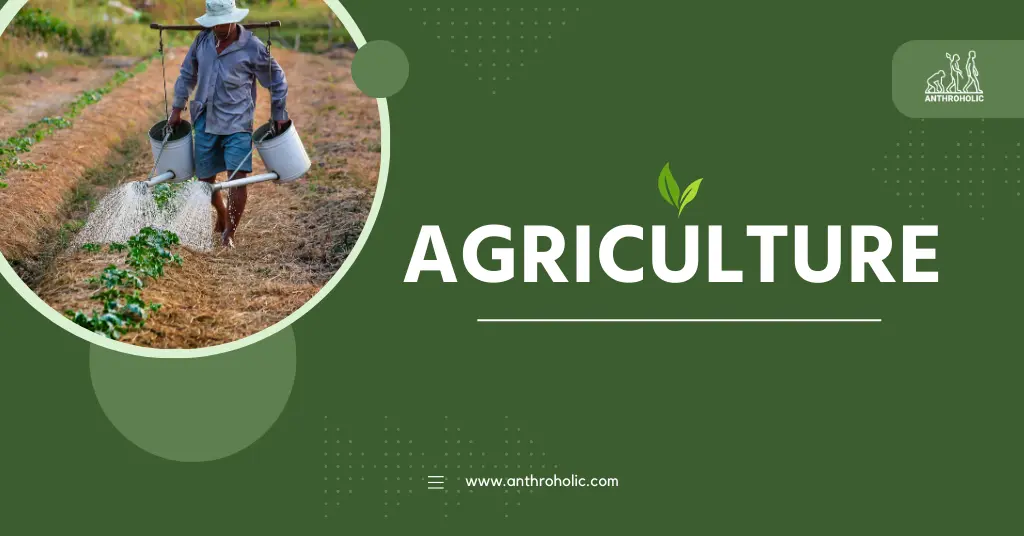AI Answer Evaluation Platform Live Now. Try Free Answer Evaluation Now
Agriculture
Agriculture, which represents one of the most critical sectors in human civilization, is the practice of cultivating plants and rearing animals for food, fiber, medicinal plants, and other products used to sustain and enhance life [1].

Types of Agriculture
Agriculture can be categorized into several types, each with unique characteristics and methods.
Subsistence Agriculture
This form of farming is primarily meant for self-consumption. The entire production is aimed at maintaining the farmer’s family, leaving little or no surplus to sell [2].
| Key Features of Subsistence Agriculture |
|---|
| 1. Limited use of machinery and technological inputs. |
| 2. Labor-intensive with a significant reliance on family or community labor. |
| 3. Smaller farm sizes. |
Commercial Agriculture
This type focuses on the mass production of crops or livestock for sale, often involving large scale operations and modern agricultural techniques [3].
| Key Features of Commercial Agriculture |
|---|
| 1. Use of modern technologies and machinery. |
| 2. Capital and labor-intensive with professional managerial involvement. |
| 3. Large farm sizes. |
Plantation Agriculture
Here, a single commercial crop is grown on a large scale. Common examples include rubber, tea, coffee, cocoa, and spices [4].
| Key Features of Plantation Agriculture |
|---|
| 1. Single crop focus. |
| 2. Significant investment and labor. |
| 3. Usually takes place in tropical regions. |
Features of Agriculture
The core features of agriculture generally revolve around farming methodologies, crop types, labor use, and technology adoption.
Farming Methodologies
This primarily depends on the nature and scale of the farm. Small-scale farmers might adopt traditional practices like slash-and-burn or shifting cultivation, while large-scale farmers usually opt for mechanized methods.
Crop Types
Crop choices are influenced by the local climate, soil, and market demand. Staple crops, like wheat and rice, are commonly cultivated worldwide, while specialized crops, like tea or grapes, are grown in specific regions.
Use of Labor
Labor reliance varies widely. While subsistence agriculture is labor-intensive, commercial agriculture often relies heavily on mechanization.
Technology Adoption
Technological innovations have radically transformed agriculture, promoting efficiency and productivity. From simple tools in early civilization to today’s GPS-guided tractors, technology continues to redefine agriculture.
The Role of Agriculture in Society
Agriculture, beyond being a primary source of food, plays a pivotal role in society. It influences and is influenced by various societal factors.
- Economy: Agriculture contributes to the gross domestic product (GDP), creates job opportunities, and provides raw materials to many industries.
- Environment: Farming practices significantly affect the environment, influencing water and air quality, soil health, and biodiversity.
- Socio-cultural: Agriculture shapes human societies by dictating settlement patterns and influencing cultural practices and traditions.
Sustainability in Agriculture
As we face an increasing global population and changing climatic conditions, the sustainability of our agricultural systems is crucial.
Sustainable Practices
Farmers worldwide are embracing sustainable practices, like organic farming, agroforestry, and conservation agriculture, that aim to preserve resources and reduce environmental harm.
| Key Features of Sustainable Agriculture |
|---|
| 1. Efficient use of resources, minimizing waste. |
| 2. Protection and enhancement of soil health. |
| 3. Emphasis on biodiversity and resilience. |
The Role of Technology
Technology plays a key role in promoting sustainable agriculture. Innovations such as precision farming, drip irrigation, and genetically modified organisms (GMOs) aim to increase productivity while reducing environmental impact.
Future Trends in Agriculture
Agriculture is continuously evolving, shaped by technological advancements and societal needs.
- Urban Agriculture: As urbanization increases, farming in urban and peri-urban areas is gaining traction. This includes practices like rooftop farming and vertical agriculture.
- AgTech: Agriculture technology (AgTech) is booming, with developments in areas like drone technology, automated machinery, and AI-powered crop monitoring.
- Climate-Smart Agriculture: Given the threats posed by climate change, farming practices that are resilient to weather extremes and help mitigate climate change are being promoted.
Conclusion
Agriculture, in all its forms and features, is a testament to human ingenuity and resilience. As we continue to face global challenges, the evolution and adaptation of our agricultural practices will be key to securing a sustainable and food-secure future.
References
[1] “Agriculture,” Encyclopædia Britannica, https://www.britannica.com/topic/agriculture
[2] Ellis, F. (1998). Peasant economics: Farm households and agrarian development. Cambridge University Press.
[3] “Agricultural Business,” Investopedia, https://www.investopedia.com/terms/a/agribusiness.asp
[4] Grigg, D. (1974). The agricultural systems of the world: An evolutionary approach. Cambridge University Press.




